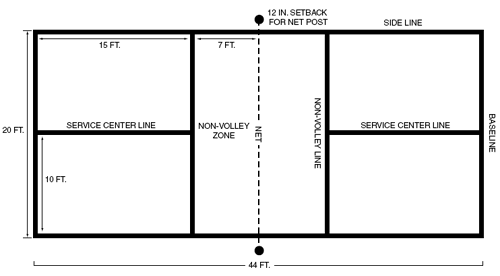 8th Grade Study Guide
8th Grade Study GuidePickleball
Background Info.
Pickleball is a combination of table tennis (ping-pong) and regular tennis that was created in 1965 on Bainbridge Island off the coast of Seattle, WA. The original purpose of the game was to provide a sport for the entire family. How did pickleball get its name? Pickles was the family dog that would chase after errant balls and then hid in the bushes, thus Pickles’ ball was shortened to the namesake of pickleball.
Initially, families played pickleball in their backyards on a hard surface, on driveways or residential dead-end streets in the 1970’s. Since, the mid-70’s, pickleball has grown and expanded from a family activity game to a net court sport with formalized rules. Now, over 30 years later, pickleball is played in thousands of educational institutions, health clubs, corporate fitness centers, and multi-purpose courts at family residences. Lobbing, overhead slams, fast volley exchanges at the net, and passing drive shots from the baseline makes this a fun and exciting game. It’s become a competitive sport with local tournaments.
The Game:
When playing pickleball the serve must be hit underhand and each team must play the first shot off the bounce. After the ball has bounced once on each side then both teams can either volley the ball in the air or play it off the bounce. This eliminates the serve and volley advantage and promotes long rallies. To volley a ball means to hit it in the air without first letting it bounce. No volleying is permitted within the seven foot non-volley zone, preventing players from executing smashes from a position with in this seven foot zone on both sides of the net. This promotes the drop volley or ‘dink’ shot playing strategies, as pickleball is a game of shot placement and patience, not brute power or strength. Bothe players on the serving team are allowed to serve, and a team shall score points only when serving.
A game is played to eleven points and a team must win by at least 2 points. A fault occurs when the ball is hit out of bounds, hit into the net, person steps into the non-volley zone and volleying the ball, or by volleying the ball before the ball has bounced on each side of the net.
Rules
The Court:
The court dimensions are identical to a doubles badminton court. The court dimensions are 20’ X 44’ for both doubles and singles. The net is hung 36 inches on the ends and 34 inches in the middle. A non-volley zone extends 7 feet on each side of the net. Thus remains 15 feet on each side of the court. On each side, these 20’ X 15’ rectangles are further divided into two equal rectangles measuring 10’ X 15’. When laying out the court, allow adequate space at each end and sides of the court boundary lines for player movement. (Three to five feet on ends and one to two feet on sides.)

The Serve:
Players must keep one foot behind the back line when serving and must serve underhand. The Paddle must pass below the waist. The server must hit the ball in the air on the serve; not allowed to bounce it, and then hit it. The serve is made diagonally cross court and must clear the non-volley zone. Only one serve attempt is allowed, except in the event of a let (ball touches the net on the serve, but lands in the proper service court). Then, the serve may be re-done. At the start of each new game, the 1st serving team is allowed only one fault before giving up the ball to the opponent. Thereafter both members of each team will serve and fault before the ball is turned over to the opposing team. When the receiving team wins the serve, the player in the right hand court will always start play.
Double Bounce Rule:
Each team must play their first shot off the bounce. That is, the receiving team must let the serve bounce, and the serving team must let the return of the serve bounce before playing it. After the two bounces have occurred, the ball can be either volleyed or played off the bounce.
Faults/Turnovers:
Ball is hit out of bounds.
Ball does not clear the net.
Player stepping into the non-volley zone and volleying the ball.
Volleying or playing the ball before it has bounced once on each side of the net.
Scoring:
A team shall score a point only when serving. A player who is serving shall continue to serve until a fault is made by his/her team. The game is played to 11 points; however, a team must win by two.